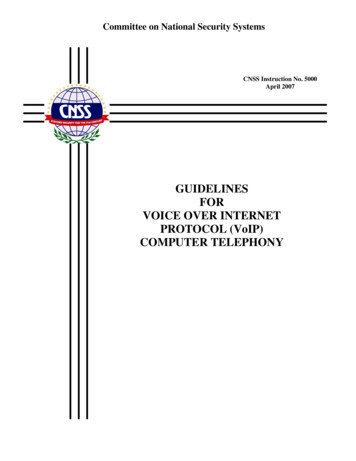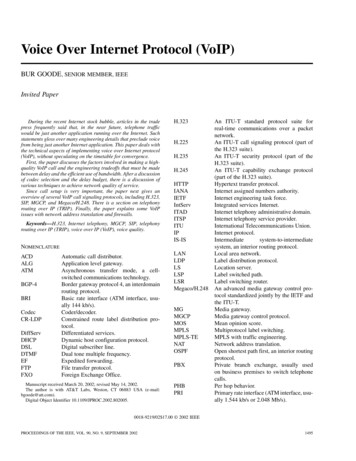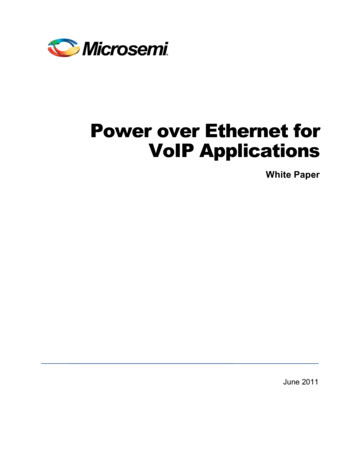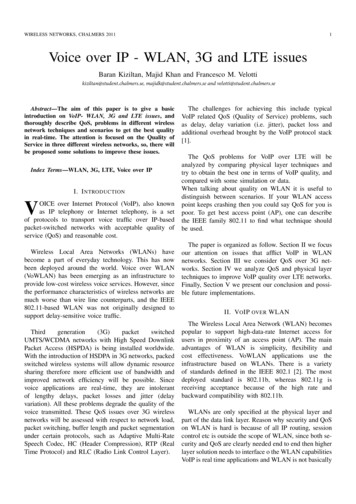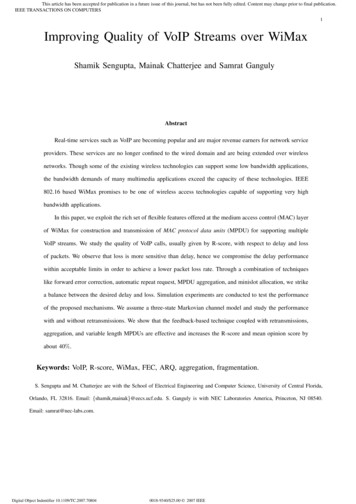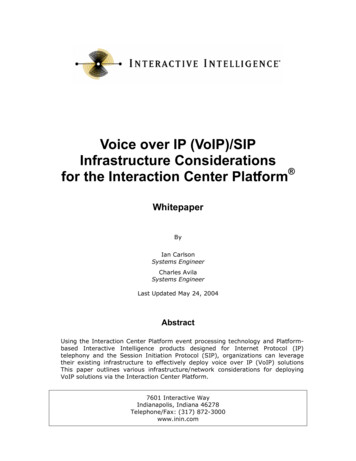
Transcription
Voice over IP (VoIP)/SIPInfrastructure Considerationsfor the Interaction Center Platform WhitepaperByIan CarlsonSystems EngineerCharles AvilaSystems EngineerLast Updated May 24, 2004AbstractUsing the Interaction Center Platform event processing technology and Platformbased Interactive Intelligence products designed for Internet Protocol (IP)telephony and the Session Initiation Protocol (SIP), organizations can leveragetheir existing infrastructure to effectively deploy voice over IP (VoIP) solutionsThis paper outlines various infrastructure/network considerations for deployingVoIP solutions via the Interaction Center Platform.7601 Interactive WayIndianapolis, Indiana 46278Telephone/Fax: (317) 872-3000www.inin.com
Copyright and Trademark Information 1994-2004 Interactive Intelligence, Inc. All rights reserved. InteractiveIntelligence , Interactive Intelligence Inc. , Interaction Center Platform ,Interaction Engine , Communité , Enterprise Interaction Center , InteractiveIntelligence Customer Interaction Center , e-FAQ , e-FAQ Knowledge Manager ,Interaction Dialer , Interaction Director , Interaction Marquee , InteractionRecorder , Interaction Supervisor , Interaction Web , Mobilité , WirelessInteraction Client , Multimedia Queuing , Interaction Administrator , InteractionAttendant , Interaction Client , Interaction Designer , Interaction Fax Viewer ,Interaction FAQ , Interaction Melder , Interaction Scripter , InteractionServer , Interaction SIP Proxy , InteractiveLease , Vocalité , and the"Spirograph" logo design are all trademarks or registered trademarks ofInteractive Intelligence Inc. U.S. and foreign patents pending.Microsoft , Windows , Windows 2000 and Windows XP are registeredtrademarks of Microsoft Corporation. Other brand and or product names are thetrademarks or registered trademarks of their respective companies. Interactive Intelligence, Inc.7601 Interactive WayIndianapolis, IN 46278Telephone/Fax: (317) 872-3000www.ININ.comInteraction Center Platform StatementThe following Interactive Intelligence products are based on the Interaction CenterPlatform event processing technology and are designed for use in SIP-enabledvoice over IP (VoIP) configurations. Customer Interaction Center (CIC) Enterprise Interaction Center (EIC) Communité Vocalité The infrastructure considerations discussed in this white paper focus primarily onthe Customer Interaction Center and Enterprise Interaction Center solutions.VoIP/SIP Infrastructure Considerations2 2004 Interactive Intelligence, Inc.
ContentsIntroduction . 4VoIP Bandwidth Considerations . 5Voice Quality Considerations. 7Quality of Service (QoS) Considerations .10Remote Site Considerations .12SIP-based Interaction Center Platform Functional Considerations .13Obtain a Network Assessment.17Appendix A: What is SIP? .18References and Further Reading.19VoIP/SIP Infrastructure Considerations3 2004 Interactive Intelligence, Inc.
IntroductionSince 2002 the Interaction Center Platform event processing technology hasenabled voice over IP (VoIP) communications utilizing the Session Initiation Protocol,or SIP. Interactive Intelligence introduced its VoIP/SIP capabilities in version 2.2 ofthe Customer Interaction Center (CIC) software built on the Interaction CenterPlatform, and today offers the same IP capabilities in the Platform-driven EnterpriseInteraction Center (EIC) IP PBX software. (The Communité (ka-mune-i-tay)unified communications software also comes SIP-enabled for VoIP.) Because CICand EIC are both application-based solutions, deploying either of them in a VoIPconfiguration allows contact centers and enterprises to leverage an existing networkinfrastructure to converge communications and applications paths. “Converged”voice and data communications also reduce costs significantly over traditional PBXand multi-box hardware systems, especially for distributed multi-site organizations.If your organization is considering the Interaction Center Platform technology forvoice over IP and SIP, this paper addresses the many aspects of planning for VoIPand the factors that impact it, including these pre-deployment considerations: Network capacity (bandwidth): Bandwidth utilization of voice devices. Quality of Service (QoS): Software for switches and routers to prioritizevoice traffic. Voice quality: Factors that can affect voice quality. Network devices: Points to consider when examining your network devices. Remote sites: How remote sites might affect your network. SIP-based Interaction Center Platform functional considerations: Howthe Interaction Center utilizes SIP. Network assessment: Why a detailed network assessment is critical to thesuccess of a voice network deployment.Note that this paper is not intended as an analysis template to gauge networkviability for a SIP-based VoIP deployment. The actual analysis of your organization’sexisting environment, and implementing a network topology into that environment,is a complex engineering process that should consider your network topology as wellas the hardware vendor you choose, the call volumes you handle and theapplications you implement. Interactive Intelligence (ININ) and or a certified ININVoIP/SIP Infrastructure Considerations4 2004 Interactive Intelligence, Inc.
Partner can assist with these engineering tasks in conducting a detailed networkassessment for your organization.Note as well that this paper is not intended to fully define SIP or the endpointscompatible with SIP deployments via the Interaction Center Platform technologyand ININ’s SIP-ready IP software solutions. Though Appendix A includes a briefoverview of SIP, we urge you to visit the SipCenter at www.sipcenter.com to learnmore about the Session Initiation Protocol, voice over IP, and the benefits theseInternet-driven communications standards provide. Interactive Intelligence is aprincipal sponsor of SipCenter along with other SIP-based VoIP vendors.VoIP Bandwidth ConsiderationsConsidering how a SIP-based Interaction Center Platform solution operates — i.e.,Customer Interaction Center (CIC), Enterprise Interaction Center (EIC) — it isimportant to factor in voice over IP bandwidth requirements. VoIP bandwidth is thecombination of a variety of factors: the CODEC used (see Voice Compression nextpage), the underlying network path (Ethernet, frame relay, ATM), the number ofcalls being handled (call volume), and the position of the Interaction Center Serverrelative to end stations. Your organization must account for each of these factorswhen sizing a SIP-based Interaction Center VoIP network.VoIP Call VolumeCall volume is determined the same way in packet- as well as circuit-switched voicenetworks. Many calculators are available to determine call volumes, such asErlang.com (www.erlang.com). The biggest difference is, instead of acquiring avoice trunk, you will use the trunk amount as a multiple against which you applyyour CODEC bandwidth.Voice PathMake sure to account for the actual audio path through every network aggregationpoint.VoIP/SIP Infrastructure Considerations5 2004 Interactive Intelligence, Inc.
Voice CompressionVarious network and phone vendors support a range of voice compressionalgorithms for assessing VoIP bandwidth. Among them is the Mean Opinion Score(MOS), a standard metric for quantifying the quality of voice compressiontechniques of different coder/decoders, or CODECs. Enacted by the InternationalTelecommunications Union (ITU), MOS scores increase from 0 to 5 as the quality ofvoice communications improve. Table 1 shows how MOS increases as the requiredbandwidth for VoIP calls increases.CompressionMethodCODECOptimalData RateMOSPacketizationDelay (msec)PCM1G.71164 kbps4.40.75ADPCMG.72632 kbps4.21LD-CELPG.72816 kbps4.23-5CS-ACELP1G.7298 kbps4.210CS-ACELP*G.729a8 kbps4.210MPMLQ*G.723.16.3 kbps3.930ACELP*G.723.15.3 kbps3.530Table 1: Mean Opinion Scores (MOS)Deployment Tip: Use the G.711 CODEC end-to-end, unless lack of capacity requirescompression.The G.711 CODEC offers the best voice quality, since it performs no compression,introduces the least delay, and is less sensitive than other CODECs to packet loss.Other CODECs, like G.729 and G.723, consume less bandwidth by performingcompression, although doing so introduces delay and makes the voice quality verysensitive to lost packets. This does not mean you can’t use G.729 across your widearea network — just make sure your WAN has little or no packet loss and minimaldelay before considering a high-compression CODEC.1- G.711 CODECs are supported by the Interaction Center Platform technology and associatedInteractive Intelligence product suite. This does not guarantee, however, that your endpoint willsupport G.711. Please check with your hardware vendor to determine CODEC support.VoIP/SIP Infrastructure Considerations6 2004 Interactive Intelligence, Inc.
Voice Compression (continued)Deployment Tip: CODEC charts specify only unidirectional (one-way) audio.Most charts discuss CODEC use in a unidirectional sense. The cost in bandwidth maydouble if your link is not full-duplex. Make sure you take this into account whensizing your network.Also, the bandwidth consumed is usually more than the optimal data rate shown inTable 1. In most TCP/IP networks, for example, Ethernet, RTP and TCP/IP headerscan increase the bandwidth requirements for a G.711 voice call from 64Kbps to89Kbps. You can verify actual bandwidth usage with a VoIP calculator (www.voipcalculator.com). The Interactive Intelligence Global Services group or a certifiedININ Partner can also help you verify actual bandwidth usage.Finally, no matter which CODEC you use, it should be used consistently across yournetwork. Moving from G.711 to G.729 across various points, for instance, willincrease the number of Display System Protocols (DSPs) your network requires andwill negatively affect voice communications quality.Voice Quality ConsiderationsParamount to the success of any VoIP deployment is the ability to maintain a highlevel of voice quality. More than any other factor, poor voice communications qualityis what causes many VoIP rollouts to fail or come up short. But while some issuesare unavoidable, the majority of call quality issues can be resolved with the propernetwork design and VoIP implementation. Following are three issues that mostaffect voice quality in VoIP networks.VoIP/SIP Infrastructure Considerations7 2004 Interactive Intelligence, Inc.
DelayDelay is the amount of time it takes a voice packet to be created, sent across thenetwork, and converted back into sound. Given the necessity of encoding voice andthe number of devices involved in a packet network, it is impossible to avoid someamount of delay in any VoIP network. The maximum acceptable delay for a voicenetwork is 150ms.One-way delay propagation delay transport delay packetization delay jitter buffer delayVoice quality drops quickly when the total one-way delay is greater than 150ms. Insuch cases, callers end up with a two-way radio effect in which they constantly“speak over each other.” Here are the aspects of delay defined in more detail.oooPropagation delay is the time that voice communications require to travel thephysical distance from end to end. For example, it may take a voice signalroughly 100ms to go from Dallas to Singapore. If your organization’s voicetraffic must cover long distances such as this, make sure your network path isas direct as possible.Transport delay is the total time a voice signal spends inside each device inthe network, including switches, routers, gateways, traffic shapers, andfirewalls. Some devices add more latency than others; for example, asoftware firewall running on a slow PC adds more delay than a dedicatedhardware-based firewall. To determine transport delay times, look at thenumber of “hops” — the number of times a voice message traverses differentnodes — that your voice traffic is forced to travel. Reducing the number ofhops requires finding ways to reduce the latency in those devices that are theworst offenders.Packetization delay is the fixed time needed for the CODEC to do its job.Again, the G.711 CODEC imposes the smallest packetization delay. Incontrast, CODECs that perform compression add delay, ranging from 25ms to67ms. And remember, it’s best to avoid converting from one CODEC toanother along your organization’s network path.Deployment Tip: Actively minimize one-way delay, keeping it below 150ms.Testing propagation and transport delayOne easy way to test propagation and transport delay is to use a TCP/IP ping to senda voice packet across the network and back. If you cannot perform a voice packetroundtrip below 250ms, your network will require optimization. Beware, however.Passing this test doesn’t necessarily mean your network is ready for VoIP. Asmentioned previously, ensuring a successful VoIP deployment requires a completenetwork assessment, so make sure whoever designs your VoIP network includes awell-designed delay plan.VoIP/SIP Infrastructure Considerations8 2004 Interactive Intelligence, Inc.
EchoEcho occurs throughout most voice networks today; as the delay in voice packetnetworks is higher, echo is much more noticeable. In effect, echo is caused by avariety of factors including wiring impedance mismatches and over-tuned gain ongateways as well as the Interaction Center Server (Customer Interaction Center orEnterprise Interaction Center) and various endpoints. Fortunately, many SIPphones, gateways and the Interaction Center Server provide echo-canceling buffersto remove some amount of echo from the audio stream. For more information, readthe “SIP Application Note” from Interactive Intelligence. (See References andFurther Reading at the end of this paper.)Deployment Tip: Avoid low-cost analog endpoints at either end of the audio path.Another factor contributing to echo is inexpensive analog devices that aren’tdesigned for SIP and VoIP. Avoid analog speakerphones attached through a gatewayif possible, since these devices are notorious for causing echo problems.JitterJitter occurs when voice packets arrive at an interval greater than they are sent. Forexample, packets may leave the Interaction Center Server every 20ms yet arrive25ms apart, which can cause obvious losses in voice quality since the voicecommunication will sound “stuttered.” In cases like this, jitter buffers are used todampen variations in packet arrival rates. Also if network delay is low and jitter ishigh, you can afford to have a larger jitter buffer than in a network where the delayis already high.To get the most out of any SIP-based VoIP solution, organizations must achieve abalance between the jitter, delay and echo that varies greatly from network tonetwork. Your organization can therefore expect a bit of fine-tuning with any VoIPdeployment.VoIP/SIP Infrastructure Considerations9 2004 Interactive Intelligence, Inc.
Quality of Service (QoS) ConsiderationsQuality of Service is a set of features that allow your organization to prioritize certainvoice packets as they traverse your network. Without QoS, voice packets can sufferintolerable delays as they contend with other traffic (http, ftp, e-mail) that is muchmore tolerant of delay and packet loss.The Interaction Center Platform event processing technology utilizes a standardknown as Differentiated Services (DiffServ) to mark voice packets. Every packetleaving the Interaction Center Server (Customer Interaction Center, EnterpriseInteraction Center) is set with the IP Precedence adjusted to 5, or Critical. Thissetting allows network administrators to differentiate voice traffic on switches androuters to ensure minimal latency.Different vendors also will utilize this information for various queuing algorithms.Check with your network provider for QoS support and use the latest queuingtechniques the provider recommends.Deployment Tip: Use priority scheduling (QoS) for voice traffic.Without QoS in place, voice quality will suffer. To guarantee voice quality whenusing the IP solutions from Interactive Intelligence, QoS must be in place from everystation to the Interaction Center Server. (Watch for adverse affects on yourorganization’s existing data traffic, though.) QoS is the subject of numerous booksand training courses. Contact your network provider for information specific to theirimplementation of QoS.Deployment Tip: Keep packet loss well below 0.1% to avoid bursts of consecutivelost packets.Minimizing voice packet loss is a large part of maintaining VoIP quality. Becauseeach packet contains a subset of the overall communication, packets that are lost ordropped due to network congestion decrease the resultant voice quality.Packet loss occurs because of congestion or electromagnetic noise. It can also occurwhen jitter is high and the jitter buffer is too small to compensate. Increasedbandwidth and good tuning can often reduce network congestion, which in turnreduces jitter and packet loss. Also, VoIP packets are very sensitive to collisions.Avoid the use of hubs at any point in the network to avoid collisions.VoIP/SIP Infrastructure Considerations10 2004 Interactive Intelligence, Inc.
Network Device ConsiderationsSelecting the network elements that make up your organization’s VoIP/SIPinfrastructure is a critical task. These devices must provide the capacity,redundancy, interfaces and feature sets required to successfully deploy a SIP-basedVoIP solution.The following items are worthy of noting when selecting network devices for a VoIPdeployment. Network devices in the VoIP network should deliver:Gateways SIP signaling (RFC 3261) support on TDM gateway devices Industry-standard CODEC support (G.711, G.729, etc.)All Devices Wire-speed operation while under heavy load with Quality of Service (QoS)services enabled Hardware-based QoS mechanism supporting IEEE standard 802.1p/Q Provisioning tools for delivery of IntServ and DiffServ QoS methodologies Switching fabric capable of sustaining network bandwidthAlthough the Interaction Center Platform technology supports enterprise and contactcenter applications riding over SIP-enabled VoIP, Interactive Intelligence continuesto perform interoperability tests against common network infrastructure switches,VoIP gateways and endpoints. For an updated list of these tested devices refer tothe “3rd party SIP Application Note” from Interactive Intelligence. (See Referencesand Further Reading at the end of this paper.)VoIP/SIP Infrastructure Considerations11 2004 Interactive Intelligence, Inc.
Remote Site ConsiderationsMany distributed organizations look to a VoIP network to link regional and localbranch offices (and add new ones), to centralize call control between sites, and toavoid toll charges by sending calls over their existing data network. They also seea VoIP network as a vehicle for globally deploying data applications to remoteoffices — without having to install expensive equipment at each site.Unfortunately, wide area networks can create new challenges and actually makeexisting problems worse. In addition to the network challenges they face, multi-siteorganizations must also consider those services that are critical to daily businessfunctions at each remote location.Local CallingIn most centralized VoIP deployments, all calls come in through a single entry pointand are routed through that point (
Also, the bandwidth consumed is usually more than the optimal data rate shown in Table 1. In most TCP/IP networks, for example, Ethernet, RTP and TCP/IP headers can increase the bandwidth requirements for a G.711 voice call from 64Kbps to 89Kbps. You can verify actual bandwidth usage with a VoIP calculator (www.voip-calculator.com).

